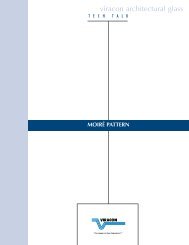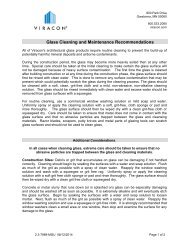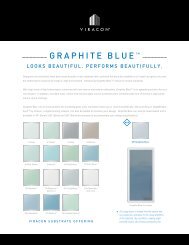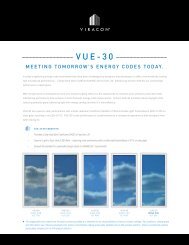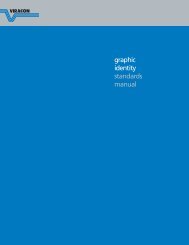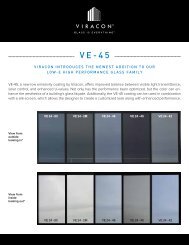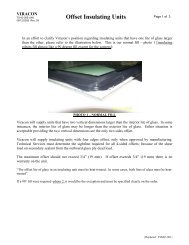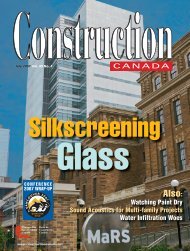2 0 1 3 P R O D U C T G U I D E VIRACON PRODUCT GUIDE 2013 ...
2 0 1 3 P R O D U C T G U I D E VIRACON PRODUCT GUIDE 2013 ...
2 0 1 3 P R O D U C T G U I D E VIRACON PRODUCT GUIDE 2013 ...
You also want an ePaper? Increase the reach of your titles
YUMPU automatically turns print PDFs into web optimized ePapers that Google loves.
glazing guidelines<br />
glass handling and storage<br />
Care needs to be taken during handling and glazing to ensure that glass damage does not occur. Do not allow glass edges to<br />
contact the frame or any hard surface during installation. Use rolling blocks if the insulating units are rotated or “cartwheeled” on<br />
their corners. To see an example of a rolling block, refer to the Glass Association of North America (GANA) glazing manual.<br />
Improper glass storage techniques may result in damage to glass components, glass surfaces, coatings or glass breakage. Store<br />
glass crates properly to prevent them from tipping. Also, ensure proper blocking and protection from outside elements. Improper<br />
air circulation for spandrel glass may result in glass damage or staining. Refer to Viracon’s Glass Staining Tech Talk for additional<br />
information on glass staining and storage.<br />
Viracon recommends a 5-7° lean against two wide, sturdy uprights, which are capable of withstanding crate weight.<br />
Once the glass is installed, the architect, general contractor or building owner should provide for glass protection and cleaning.<br />
Weathering metals, alkaline materials or abrasive cleaners may cause surface damage. Windblown objects, welding sparks or<br />
other material that contacts the glass surface during construction may cause irreversible damage.<br />
handling instructions<br />
Translucent frits are ceramic enamels that are silkscreened onto glass and fused onto the surface during heat treatment. The<br />
silk-screening process involves depositing the frit on the glass through a nylon mesh. Due to the paint composition, the resultant<br />
surface retains some surface irregularity after it is fired onto the glass surface.<br />
Since the surface is rougher than a normal glass surface, clean conditions must exist during installation to prevent contaminants<br />
or sealants from begriming the glass. Viracon recommends wearing clean cotton or rubber gloves when handling this product.<br />
In addition, caution is recommended when working with sealants because liquid sealants that penetrate the porous surface may<br />
become difficult to remove once cured. Be aware of the rough surface so appropriate precautions can be taken by the other trades.<br />
Maintenance and storage<br />
To maintain aesthetics, it is important to clean the glass during and after construction. For routine cleaning, use a soft, clean,<br />
grit-free cloth and a mild soap, detergent, or window cleaning solution. Rinse immediately with clean water and remove any<br />
excess water from the glass surface with a squeegee. Do not allow any metal or hard parts of the cleaning equipment to contact<br />
the glass surface.<br />
Take special care cleaning coated glass surfaces. Do not use abrasive cleaners, razor blades, putty knives and metal parts of<br />
cleaning equipment, since these will scratch the coating. Fingerprints, grease, smears, dirt, scum and sealant residue are more<br />
noticeable on coated glass, requiring more frequent cleaning. Follow the same cleaning techniques used for non-coated glass.<br />
If detergent residue is still present, it can be effectively removed with a 50/50 solution of isopropyl alcohol and water. The glass<br />
surface should then be wiped dry with a clean grit-free cloth or squeegee.<br />
<strong>VIRACON</strong> // RESOURCES 127



